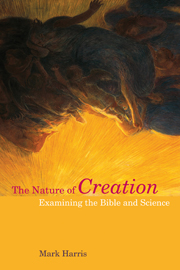Book contents
- Frontmatter
- Contents
- Preface
- Abbreviations
- 1 Introduction
- 2 Creation According to Modern Science
- 3 Creation According to the Bible I: Genesis
- 4 Creation According to the Bible II: The Creation Motif
- 5 The Framework of Biblical Cration
- 6 Creator–creation: How can a Ralationship be Described?
- 7 The Fall
- 8 Suffering and Evil
- 9 Scientific Eschatology and New Creation
- 10 Conclusions
- Bibliography
- Index of Ancient Citations
- Index
4 - Creation According to the Bible II: The Creation Motif
- Frontmatter
- Contents
- Preface
- Abbreviations
- 1 Introduction
- 2 Creation According to Modern Science
- 3 Creation According to the Bible I: Genesis
- 4 Creation According to the Bible II: The Creation Motif
- 5 The Framework of Biblical Cration
- 6 Creator–creation: How can a Ralationship be Described?
- 7 The Fall
- 8 Suffering and Evil
- 9 Scientific Eschatology and New Creation
- 10 Conclusions
- Bibliography
- Index of Ancient Citations
- Index
Summary
CREATION AND NARRATIVE
Although the Genesis creation texts are usually regarded as the primary sources of biblical creation thought, there is far more creation material spread throughout the Bible. When taken together with the Genesis accounts, it makes for a very diverse account of creation, which we will refer to as the biblical “creation motif” (see § “Creation in the Bible” in Chapter 1, above). Furthermore, while some of the additional creation material coheres with P or J (usually P), there are many other elements. This means that there is less a “theology of creation” in the Bible so much as “theologies of creation”. As Brueggemann (1997: 163–4) has explained, these theologies are united by the fact that they are testimony of “Yahweh who creates”. God does so by word (e.g. Gen. 1, but also including the prophetic word), by wisdom (e.g. Jer. 10:12) and by spirit (Gen. 1:2). We might be tempted to unite this into a single doctrine of creation, but this would abuse the integrity of the biblical witness in its diversity. The view taken in this book is that the creation motif is focussed on the nature of God, which is never easily pinned-down nor systematized in the Bible; consequently, biblical creation theology is always diverse and multi-dimensional.
- Type
- Chapter
- Information
- The Nature of CreationExamining the Bible and Science, pp. 59 - 82Publisher: Acumen PublishingPrint publication year: 2013



